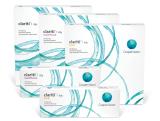Find your MiSight® 1 day certified doctor...
Olivia And Madeleine's Story
Olivia & Madeline Are Seeing the World Together
Valerie and Greg always knew their 8-year-old twins, Olivia and Madeline, might develop myopia – the medical term for nearsightedness – because they did as children. Myopia tends to run in families, and the chances of a child developing myopia increases 6x when both parents have the condition.1 “It was always a challenge,” says Valerie, remembering their childhood struggle with myopia. So naturally when the twins started struggling to see the clock from the living room, the parents worried how this might affect the twins, who are both in dance and gymnastics, and live active lives.
Myopia is the condition in which the eyeball is longer than it should be, or the cornea is curved too steeply. Instead of focusing precisely on the retina, light focuses in front of the retina, resulting in blurry distance vision.2 The end result is nearsightedness. This can easily be rectified with corrective eyeglasses, which Greg and Valerie assumed their girls would have to wear. However, they discovered they had other options that would not only correct their vision but would help to slow the progression of their myopia.
Their Eye Care Professional prescribed MiSight® 1 day contact lenses by CooperVision®. These daily disposable lenses are specially designed for myopia control and are FDA approved* to slow the progression of myopia in children aged 8-12 at the initiation of treatment.†3 The lenses offer a level of ease that both parent and child can take comfort in.4 After doing his research, Greg saw MiSight® 1 day as a “very approachable solution to the problem” that would allow his girls to continue with their hobbies as normal. Both daughters have adapted to wearing the lenses smoothly, putting them in themselves without any assistance.3 But for Madeline the most exciting thing about the lenses is “to be able to see better.3,5,6”
A key benefit of MiSight® 1 day is that these lenses help slow the progression of myopia†3 which will have a positive impact in the future of children’s eye health.7 Greg and Valerie wanted to give their daughters a better outcome when it came to their eyesight than they had, so they jumped at the opportunity to try MiSight® 1 day when their MiSight® certified Eye Care Professional offered the lenses to them. “The studies showed that it did slow the progression of their myopia,” says Valerie, “I wanted to give them that advantage.”
For consumer care call:1-855-526-6737
Indications and Important Safety Information
Rx only. Results may vary.
Rx only. Results may vary.
ATTENTION: USA Indications: MiSight® 1 Day (omafilcon A) Soft (Hydrophilic) Contact Lenses for daily wear are indicated for the correction of myopic ametropia and for slowing the progression of myopia in children with non-diseased eyes, who at the initiation of treatment are 8-12 years of age and have a refraction of -0.75 to -4.00 diopters (spherical equivalent) with ≤ 0.75 diopters of astigmatism. The lens is to be discarded after each removal. Canadian Indication: MiSight (omafilcon A) Soft Contact Lenses for Myopia Control are indicated for the correction of ametropia (myopia and hyperopia) in aphakic and non-aphakic persons with non-diseased eyes in powers from -20.00D to +2.00 diopters. The lenses may be worn by persons who exhibit astigmatism of -2.00 diopters or less that does not interfere with visual acuity. MiSight (omafilcon A) Soft Contact Lenses for Myopia Control may reduce the rate of myopia progression in children (6-18) and correct ametropia. Reduction of myopia progression was observed in children with wearing time of 12 hours (8-16 hours) per day, 6.4 days (5-7) per week in a clinical study. Permanent myopia control after lens treatment is discontinued is not supported by clinical studies. MiSight (omafilcon A) Soft Contact Lenses for Myopia Control are indicated for single use daily disposable wear. When prescribed for daily disposable wear, the lens is to be discarded after each removal. Warnings: Problems with contact lenses could result in serious injury to the eye. Do not expose contact lenses to water while wearing them. No overnight wear. Patients should exercise extra care if performing potentially hazardous activities. Adverse events: Including but not limited to infection/inflammation/ulceration/abrasion of the cornea, other parts of the eye or eyelids. Some of these adverse reactions can cause permanent or temporary loss of vision. If you notice any of the stated adverse reactions in your child, immediately have your child remove the lenses and contact your eye care professional.
† Compared to a single vision 1 day lens over a 3 year period.
References:
- Mutti DO, Mitchell GL, Moeschberger ML, Jones LA, Zadnik K. Parental myopia, near work, school achievement, and children's refractive error. Invest Ophthalmol Vis Sci. 2002;43(12):3633-3640. doi:10.1001/jamaophthalmol.2020.0412.
- https://www.mayoclinic.org/diseases-conditions/nearsightedness/symptoms-causes/syc-20375556.
- Chamberlain P, et al. A 3-year randomized clinical trial of MiSight® lenses for myopia control. Optom Vis Sci. (2019); 96(8):556-567.
- CVI data on file 2019. Global survey by Decision Analyst with 1,009 parents in UK, Canada, Germany, Spain, Hong Kong, Australia/NZ.
- Sulley A et al, Wearer experience and subjective responses with dual focus compared to spherical, single vision soft contact lenses in children during a 3-year clinical trial. AAO 2019 Poster Presentation.
- Chamberlain P et al, Further comparison of myopia progression in new and established myopia control treatment (MiSight® 1 day) groups. BCLA paper presentation 2019.
- CVI data on file 2019. Global survey by Decision Analyst with 402 ECPs in UK, Canada, Germany, Spain, Hong Kong, Australia/NZ.






